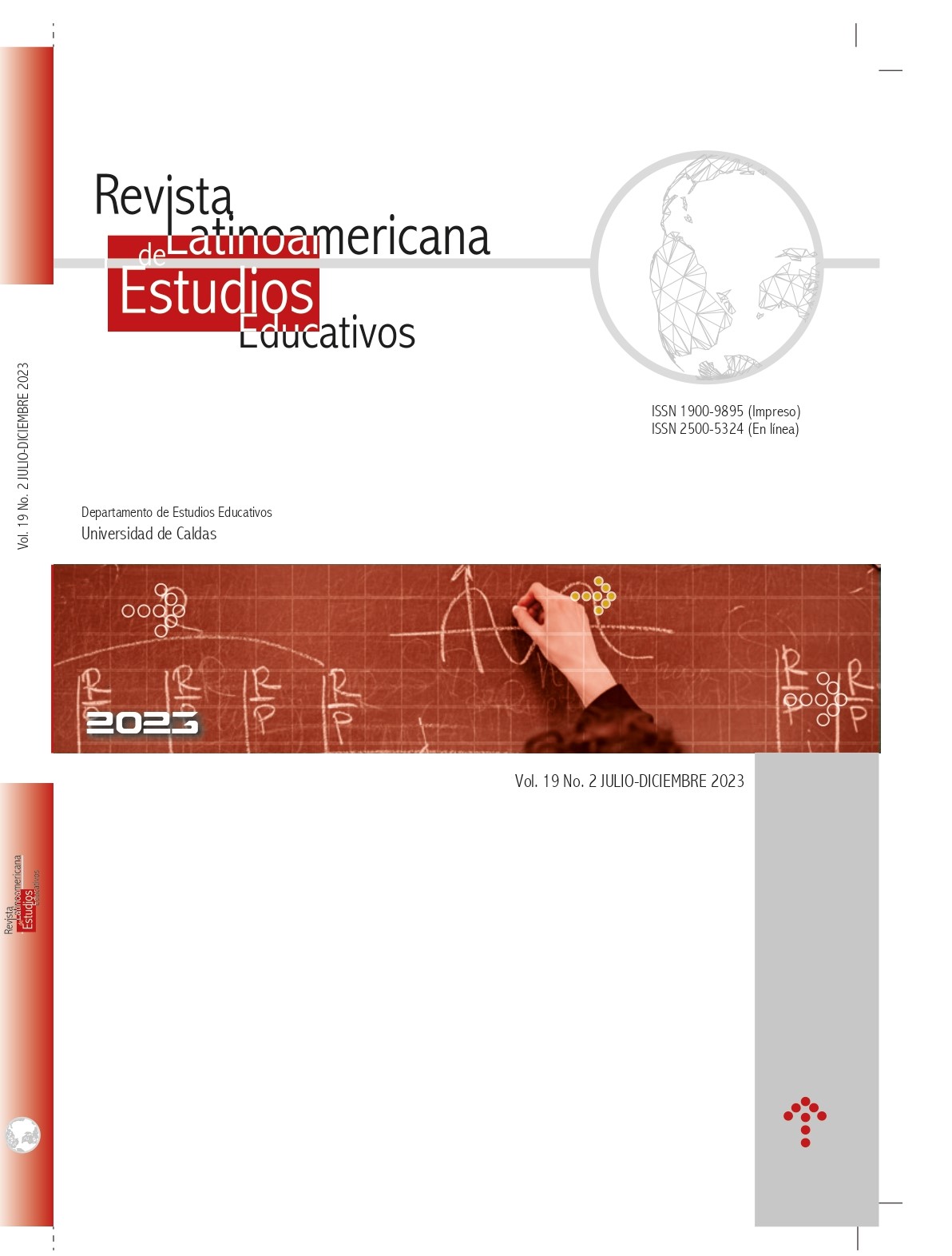Authors
Abstract
Communication in the natural science classroom is crucial for learning. This research analyzed the semantic code “semantic gravity” in chemistry classes of four teachers in the city of Manizales, Colombia. The main goal of the research was to identify how the semantic gravity of the teacher is related to the semantic gravity of the students and their performance in the topic of pH in chemistry. The research, is of a descriptive-comprehensive type, involved teachers and students from four public educational institutions. Classes were recorded and the discourse was analyzed to identify moments of weak and strong semantic gravity, corresponding to the level of remoteness or closeness to the context and daily life of the students. Discourse profiles were created for teachers and correlated with student scores on open-ended tests. It was found that a dynamic teacher discourse facilitates the learning of scientific concepts. In addition, it was found that teachers' semantic gravity profiles influence students' performance. On the other hand, it was observed that some teachers were able to relate abstract concepts with everyday situations, which motivated students to better understand the knowledge of the area of chemistry, specifically in the topic of pH.
References
Bernstein, B. (2006). Vertical and horizontal discourse: an essay. British Journal of Sociology of Education, 20(2), 53-73.
Blackie, M. A. L. (2014). Creating semantic waves: using Legitimation Code Theory as a tool to aid the teaching of chemistry. Chemistry Education Research and Practice, 15(4), 462-469. https://doi.org/gw3w
Brooke, M. (2019). Guiding teachers talk in the content and language integrated learning classroom using semantics from legitimation code theory. Teaching in Higher Education, 25(7). https://doi.org/gw3x
Chamizo Guerrero, J. A. e Izquierdo i Aymerich, M. (2005). Ciencia en contexto: una reflexión desde la filosofía. Alambique: didáctica de las ciencias experimentales, 46, 9-17. https://dialnet.unirioja.es/servlet/articulo?codigo=1299933
Córdova, J., Melo, G., Bacigalupo, F. y Mangui, D. (2016). Olas de significado en la interacción profesor-alumno: análisis de dos clases de Ciencias Naturales de un 6to de primaria. Ciência & Educação, 22(2). https://doi.org/10.1590/1516-731320160020005
Cutrera, G., Massa, M. y Stipcich, S. (2019). Contextualización del discurso docente y explicaciones científicas en el aula de ciencia: un estudio de caso durante la residencia docente. Revista de enseñanza de la Física, 31(Extra 1), 251-258. https:// dialnet.unirioja.es/servlet/articulo?codigo=7578675
Domènech-Casal, J. (2022). Reflexiones y orientaciones para el despliegue del nuevo currículo de ciencias en la ESO. Ciències, 45, 1-19. https://doi.org/10.5565/rev/ciencies.468
Doran, Y. L., Maton, K., & Martin, J. R. (2021). The teaching of science: New insights into knowledge, language and pedagogy. In K. Maton, J. R. Marton & Y. J. Doran (Eds.), Teaching Science: Knowledge, Language, Pedagogy (pp. 1-20). Legitimation Code Theory.
Garduño Román, S. A. (2002). Enfoques metodológicos en la investigación educativa. Investigación administrativa, 30(91), https://biblat.unam.mx/hevila/InvestigacionAdministrativa/2002/vol31/no90/2.pdf
Halliday, M. A. K. (1982). El lenguaje como semiótica social: la interpretación social. Fondo de Cultura Económica.
Henríquez, R. F. y Fuentes Cortés, M. (2018). Aportes de la Lingüística a la Educación Histórica. Historia y memoria, (17), 219-250. https://doi.org/10.19053/20275137.n17.2018.7449
Hood, S. (2019). Live Lectures: The significance of presence in building disciplinary knowledge. In K. Maton, J. R. Marton & Y. J. Doran (Eds.), Teaching Science:
Knowledge, Language, Pedagogy (pp. 179-208). Legitimation Code Theory.
Humphrey, S. & Robinson, S. (2012). Resourcing teachers to tide the semantic wave to whole school literacy development. Australian Association for Research in Education.
Lemke, J. L. (1997). Aprender a hablar ciencia: lenguaje, aprendizaje y valores. Paidós.
Lidia, M. B., Yedid, S. V., Lino, A. C. y López, I. S. (2015). Secuencia didáctica en la enseñanza de "ácidos y bases" nivel secundaria. Revista Iberoamericana de producción académica y gestión educativa, 2(4). https://www.pag.org.mx/index.php/PAG/article/view/379/417
Macnaught, L., Maton, K., Martin, J. R. y Matruglio, E. (2013). Jointly constructing semantic waves: implications for teacher training. Linguistics and Education, 24 (1), 50-63. https://doi.org/gh6rm3
Martínez Lirola, M. (2007). Aspectos esenciales de la gramática sistémica funcional. Universidad de Alicante.
Maton, K. (2013). Making semantic waves: a key to cumulative knowledge-building. Elsevier. Linguistics and Education, 24, 8-22. https://doi.org/gctr7c
Maton, K. (2014). Knowledge and Knowers: Towards a realist sociology of education. Routledge.
Maton, K., Hood, S., & Shay, S. (2015). Knowledge-building: educational studies in Legitimation Code Theory. Routledge.
Maton, K., & Doran, Y. J. (2017). Semantic density: A translation device for revealing complexity of knowledge practices in discourse. Onomázein, 46-76.
Maton, K. & Doran, Y. J. (2021). Constellating science: How relations among ideas help build knowledge. In K. Maton, J. R. Martin y Y. J. Doran (Eds.), Teaching Science: Knowledge, language, pedagogy (pp. 49-75). Routledge.
Mortimer, E. F., & Wertsch, J. V. (2003). The Architecture and Dynamics of Intersubjectivity in Science Classrooms. Mind, culture, and activity, 10(3), 230-244 https://doi.org/gw32
Olivares Petit, C. y Leyton Román, F. (2023). Niveles de abstracción como propuesta de seguimiento, desde la didáctica de las ciencias. Tecné, Episteme y Didaxis: TED, (número extraordinario), 3274-3280. https://revistas.upn.edu.co/index.php/TED/article/view/14990
Rincón Corredor, H. M. (2013). Propuesta didáctica para el aprendizaje del concepto de pH en estudiantes de básica secundaria [Tesis de doctorado, Universidad Nacional]. https://repositorio.unal.edu.co/handle/unal/75191
Sanmartí Puig, N. y Márquez Bergalló, C. (2017). Aprendizaje de las ciencias basado en proyectos: del contexto a la acción. Ápice: Revista de Educación Científica, 1(1), 3-16. https://doi.org/10.17979/arec.2017.1.1.2020
Svensson, B. (2019). The construction of semantic waves of knowledge-building: High school students’ natural science writing. HERMES Journal of Language and Communication in Business, 59(1), 139-152. https://doi.org/10.7146/hjlcb.v59i1.117037
Usategui Basozabal, M. E. (1992). La sociolingüística de Basil Bernstein y sus implicaciones en el ámbito escolar. Espacio y Tiempo: Revista de Ciencias Humanas, 7, 143-174. http://hdl.handle.net/11162/70351
Vidal Lizama, M. (2017). Knowledge in your classroom: A model of analysis for specialization codes in classroom discourse. Onomázein, (II), 149-178. https://doi.org/10.7764/onomazein.ne2.06

 PDF (Español)
PDF (Español)
 FLIP
FLIP
























